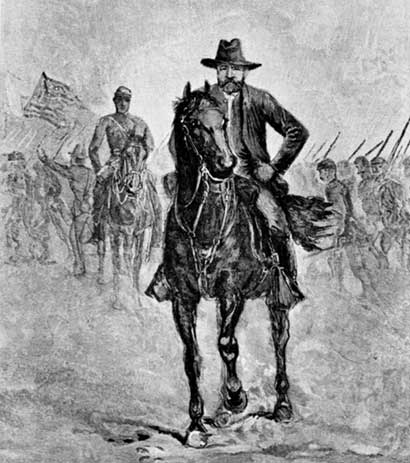|
RICHMOND National Battlefield Park |
 |
PART TWO
THE FINAL STRUGGLE FOR RICHMOND, 1864-65

Gen. Ulysses S. Grant.
From a contemporary sketch.
Lincoln's New Commander
In March 1864 President Lincoln appointed Gen. Ulysses S. Grant as commanding general of all the Union armies. Said Grant: "In the east the opposing forces stood in substantially the same relations toward each other as three years before, or when the war began; they were both between the Federal and Confederate Capitals. Battles had been fought of as great severity as had ever been known in war * * * from the James River to Gettysburg, with indecisive results." He hoped to change this situation by putting pressure on all Confederate armies at the same time, something that had never been done before.
Grant's plan called for Gen. Benjamin F. Butler to march up the south side of the James and attack Petersburg or Richmond or both; Gen. Franz Sigel to push down the Shenandoah Valley driving Gen. Jubal Early before him, thereby protecting Washington; Gen. Nathaniel Banks in New Orleans to march on Mobile; Gen. William T. Sherman to cut across Georgia driving Johnston before him, take Atlanta, and if necessary swing north to Richmond; Meade's Army of the Potomac, with Grant in command, to push Lee's Army of Northern Virginia and capture Richmond. As Grant stated: "Lee, with the Capital of the Confederacy, was the main end to which all were working."
Lee's objective now was to stop Grant and protect Richmond. Said Lee: "We must destroy this army of Grant's before he gets to the James River. If he gets there it will become a siege, and then it will be a mere question of time."
The campaign started in the spring of 1864 when the Army of the Potomac crossed the Rapidan River and the Army of Northern Virginia blocked its path at the Wilderness. After a particularly vicious and costly battle, Grant instead of retreating to lick his wounds as other Federal commanders had done, executed a left flank movement, still heading south and trying to get between Lee and Richmond. A few days later the two armies clashed again at Spotsylvania in a series of grim battles, but still indecisive as far as major objectives were concerned. Although Grant's losses were staggering, he was slowly but methodically destroying Lee's ability to wage offensive war.
Again Grant executed a left flank movement to get around Lee, and then by a series of flanking marches, which the Confederate soldiers called the "sidling movement," and the Union soldiers the "jug-handle" movement, Grant gradually worked his way down to Cold Harbor.

|

|
|
Last Modified: Mon, Mar 4 2002 10:00:00 pm PDT |


